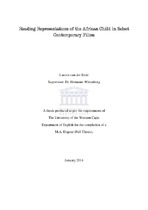| dc.description.abstract | Framed by theories of childhood, psychoanalysis, postcolonial theory, trauma theory, film theory, and literary theory, this thesis investigates representations of the African child in three contemporary films about Africa. This thesis puts forward the argument that in E. Zwick‘s Blood Diamond Dia, the film‘s primary child character, is split into Dia Vandy (his subjectivity) and See-me-no-more (his performed identity within the Revolutionary United Front). Furthermore it will be shown that this split is paralleled by the boy‘s transition from filiation to re-filiation. With regard to K. MacDonald‘s The Last King of Scotland, this thesis will demonstrate how, via the effects of cinematic doubling, the narrative antagonist Ugandan dictator Idi Amin Dada is represented as a child. It will also be illustrated that the narrative, consequently, perpetuates not only the myths surrounding Amin but the colonial myth that the savage is a child. Finally, this thesis will show that, of the tree texts, N. Blomkamp‘s District 9 boasts the most authentic representation of the African child and childhood in postcolonial Africa, albeit via a child figure that is literally alien. In each case study the child will be shown to be a liminal personae (Turner 1969), who is an ambiguous and often paradoxical figure who allows us to see more clearly the ethical tensions within the narrative. This thesis will also show that these texts may be considered socially aware trauma narratives, which are relatively critical of western involvement in the traumatic histories of African locales and peoples. Ironically though, these texts, and others similar to them, have been criticised for being Afropessimistic (Evans & Glenn 2010). The tension created by this paradox will be investigated during this thesis, which will attempt to establish to which extent these texts may be considered postcolonial, and whether or not they should be labelled Afropessimistic. | en_US |

